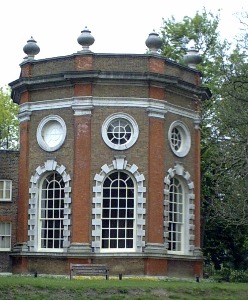
Route & what to see
|
A Twickenham Walk Route & what to see |
| london-footprints.co.uk |
A 3 mile circular walk from St Margarets Station
From the station go right and
then left around The Barons
Twickenham Film Studios location
Go down Sandycombe Road
opposite
Sandycoombe Lodge on the corner was the home of the artist JMW
Turner from 1813-26.
Enter Marble Hill Park
The Palladian villa which was built in the 1720s for Henrietta
Howard, the mistress of George II, is now in the care of English
Heritage. The park is open to all and there is a cafe in the
stable block.
Exit onto the riverside path
passing an old Black Walnut tree and go to the right. Continue
through Orleans Gardens and under two footbridges along
Riverside.
On the right is Dial House, the home of the Twining (tea) family
from 1722. It was donated to the parish for use as a vicarage in
1890.
Continue along the Embankment
Number 25 (c1720) now houses the Twickenham Museum (see below)
but has been the home of the Twining and Hammerton (ferry)
families. The Mary Wallace Theatre is housed in what was once a
mission room housing the parish soup kitchen. On the left is Eel
Pie Island which can be reached via a footbridge. There is a
riverside plaque with information on its musical history opposite
the Barmy Arms pub (former Queen's Head).
Go right up Bell or Water Lane
and right along Church Street
This would have been the main street at one time.
Go right down Church Lane
St Mary's was in existance before 1332. It was rebuilt in 1713 by
John James after the nave collapsed but retains its Medieval
tower. It is the burial place of Alexander Pope.
At the river go through the
gate to the left into the riverside gardens
The last resident of York House, Sir Ratan Tata, designed these
gardens which include the fountain known as 'the Naked Ladies'
Cross the footbridge into the
other half of the gardens
York House built in 1635 is now in council use. The grounds
include a Japanese Garden, tennis courts and a metal urinal.
Exit into Sion Road and go
right, then left through Ferry Road into Lebanon Park. Go to the
right back to Riverside then left and enter the grounds of the
Orleans House Gallery to the left just beyond the overhead bridge
Orleans House was built in 1710 by John James for James Johnston,
Secretary of State for Scotland. From 1815-7 it was occupied by
Louis Philippe, Duc d'Orleans (later King of France) during his
exile (hence the name). The Octagon was designed by James Gibbs
in 1720 as a garden pavilion. The house was demolished in 1926
but the Octagon and adjoining wings were saved by Mrs Ionides and
now house a gallery. The former stables block has more gallery
space and a cafe.
Exit through the wooded
grounds into Orleans Road and go left.
There is a former school of 1856.
Go right through Chapel Road
into Montpelier Row
The fine houses date from the 1720s and there are plaques to
Walter de la Mare and Tennyson.
From Montpelier Row cross
Richmond Road and go along Crown Road opposite back to the
station
london-footprints.co.uk 2010
Resources
The Twickenham TIC is in the Civic Centre in York Street
Tel 020 8891 7272.
The Twickenham Museum is housed in 25 The Embankment. Admission
is free but opening is limited to Tues & Sat 11-3 and Sun
2-4. Tel 020 8408 0070. The award-winning website has lots of information on the area.
St Mary's Church has a website
There are guided walks available on summer Sunday afternoons led
by voluntary guides (charge) Tel 020 8977 2806.
A history of Orleans House can be downloaded [click here] There are 4 large PDF files.
[places to visit] [English Heritage] [walks list]